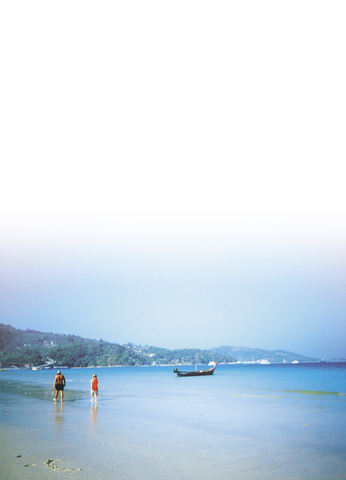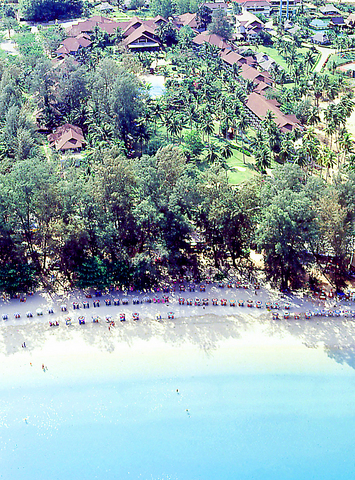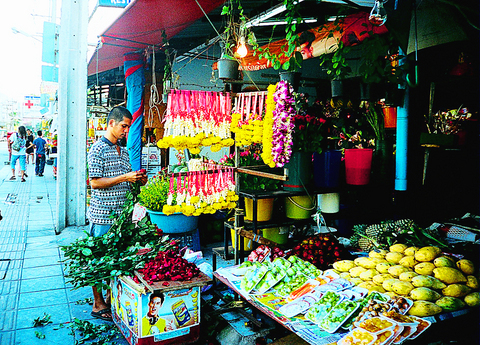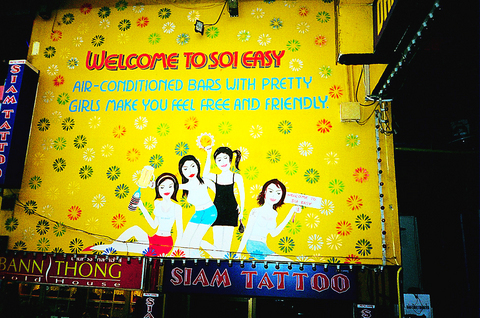Many people's first reaction upon hearing of a visit to Thailand's famous Phuket Island or other tourist destinations in the area is "But wasn't it all destroyed in the tsunami?"
They refer, of course, to the massive tidal wave of Dec. 26 last year that swept thousands of people to their deaths and laid waste to coastal areas in Indonesia, Sri Lanka, India, Malaysia and Thailand.
Phuket, specifically the west side of the island -- the east coast sustained very little or no damage whatsoever -- wasn't spared the tsunami and the images that stick in the mind are those of unsuspecting tourists in the wrong place at the wrong time.

That was then.
In fact, Phuket and Thailand's five other tsunami-hit provinces were not hit nearly as hard as Indonesia or Sri Lanka, where entire villages disappeared under the wave.
Locals are nearly unanimous in their condemnation of media reports at the time, saying the level of destruction was overstated and that false claims about the loss of life were made.

PHOTO: PEARL VILLAGE
The amount of media that flew in and set themselves up as immediate experts on all things Thai was quite a circus to observe, they say. Many journalists were based in five-star hotels on Phuket's beaches, yet their respective reports aired footage of Banda Aceh and Sri Lanka, giving viewers a false impression of what had happened in Phuket.
In reality, the island's residents immediately started the clean-up effort and worked days and nights to remove debris from the beaches. They know better than anyone that the island is heavily dependent on tourism and if no one returned to Phuket, their livelihoods would also disappear.
The island's famous Patong, Kata and Karon beaches all sustained some degree of damage, mostly to the tourist-traps and shops along the beachfronts.

PHOTO: CARINA MCINTOSH
The beaches themselves, meanwhile, have been restored to a degree of pristine beauty not seen for many years, and the sand quality and water quality have improved significantly.
Locals are quick to point out that one can now swim at Patong Beach without fear of eye infections and skin rashes.
"The beach is like it was at the beginning of tourism 30 years ago," Somchai Silapananon of the Phuket Tourism Association said before the start of the "Love Andaman" festival held on the island at the beginning of this month.

PHOTO: CARINA MCINTOSH
The festival was planned by the Tourism Authority of Thailand (TAT), Thai Airways International and the Federation of Thai Industries to restore confidence in the tourism industry and to help Thailand's six tsunami-hit provinces on the Andaman Sea coast.
"Only 10 percent to 20 percent of shallow-water coral reefs were destroyed and most of the prime diving sites now offer even better diving, thanks to the improved water quality," TAT president Wichit Na-Ranong said.
In Patong, the improved water quality could be attributed in part to damaged beachfront hotels currently being closed for rebuilding and redecoration and the resulting reduction in waste-water output.

Fishermen have also noted rises in catches of up to 100 percent and the return of fish species that had not been seen in reef areas for years because of deteriorating water quality. Many of them are saying that the tsunami opened up ancient natural underwater "food channels" and breeding grounds that might have been clogged or sanded up for centuries because of human activities in the region.
The main concern of the Patong hospitality industry is to ensure that the improved water quality is maintained.
"Once all the businesses return, it will be hard to maintain the pristine quality," Patong hotelier Lily Udomkunatum said.
Unfortunately, the "Love Andaman" festival had to be cancelled after a huge storm swept over the island, flooding the venue on the beach and collapsing the massive stage that had taken three days to construct.
The storm also knocked out most of the electricity in Patong, which meant that most restaurants and bars either closed for the night or used candles and lamps to provide light, turning the normally neon-illuminated Rat-U-Tit Road into a fairyland of flickering flames.
No electricity also meant that none of the automatic bank teller machines in the area were working and some visitors -- myself included -- were stuck without cash.
Fortunately, the hospitality industry in Patong is geared to cope with any disaster, so when we entered the Aussie Bar -- one of the liveliest bars on Soi Easy just off the bustling red-light area on Bangla Road -- not having ready cash was not a problem. The very understanding Australian expat owner merely shrugged it off with "It happens sometimes," and allowed the entire group to eat and drink on a tab.
The check could be settled later when the teller machines were up and running again, he said, without raising an eyebrow -- now that's hospitality.
Another excellent example of nature restoring what man -- and in this case Hollywood -- has destroyed, is Ao Maya, or Maya Bay. The bay that was put on the international tourist map by the Leonardo DiCaprio backpacker epic, The Beach, is tucked into Phi Phi Leh, a tiny, uninhabited island that is part of a national park next to the main resort island, Phi Phi Don, off Krabi.
In 1999, the film's producers cleaned the bay of rubbish, stripped the vegetation, planted a grove of coconut palms on the beach and levelled the sand dunes. Locals say the beach never recovered.
"The sand dunes were damaged during filming because there is a scene where the actor had to play soccer on the beach and the beach did not have a wide enough space so they brought in a tractor to widen it," said Nattawuth Kaenthong, a Phi Phi resident.
With the first monsoonal storms, Nattawuth said, all the sand was washed away. The Thai government had to use sacks of sand to replace the flattened dunes.
"Before the tsunami hit there were no sand dunes at all. But afterwards, everything came back just like the old times," Nattawuth said.
Marius Goring of Bangkok told me that when he last visited Phi Phi for a few days a year ago, he vowed never to go back to the islands because of the disgusting state they had fallen into before the tsunami.
He said the beaches were so crammed full of boats that there was no room for tourists to swim even if they wanted to risk being covered by oil leaking from the boats' engines. A foul smell hung in the air, Goring said, and some of the beaches had the appearance of an open sewer.
After the tsunami, however, boat traffic to the islands has decreased and the rejuvenated beaches again sport the clear, azure water that made them such inviting tourist destinations in the first place.
On the Krabi mainland the Hat Noppharat Thara -- Koh Phi Phi National Marine Park suffered minimal damage but repairs have been made and the beaches have already returned to normal tourist capacity.
Further south, Hat Rai Leh and Hat Tham Phra Nang, two of the most beautiful beaches in Krabi, were hardly touched by the giant wave.
Most of the debris on Krabi's damaged beaches has been cleared and recovery work is well underway. All tourist accommodations on the east side of Phi Phi Don -- including the Holiday Inn Phi Phi Island, Phi Phi Island Village Resort, PP Coral Resort and Spa, and Phi Phi Natural Resort -- are open for business, as are those along Hat Yao at the island's southeast corner. Ferries to Phi Phi Don from Krabi and Phuket are in operation once again.
In short, there hasn't been a better time to head to Phuket or Krabi for an island-paradise holiday most people can only dream about.
Instead of destroying the natural beauty of the area, the tsunami in this case flushed away the garbage and filth and left a paradise rejuvenated and restored to its natural splendor, enjoying a welcome respite from pollution and overcrowding.

That US assistance was a model for Taiwan’s spectacular development success was early recognized by policymakers and analysts. In a report to the US Congress for the fiscal year 1962, former President John F. Kennedy noted Taiwan’s “rapid economic growth,” was “producing a substantial net gain in living.” Kennedy had a stake in Taiwan’s achievements and the US’ official development assistance (ODA) in general: In September 1961, his entreaty to make the 1960s a “decade of development,” and an accompanying proposal for dedicated legislation to this end, had been formalized by congressional passage of the Foreign Assistance Act. Two

March 31 to April 6 On May 13, 1950, National Taiwan University Hospital otolaryngologist Su You-peng (蘇友鵬) was summoned to the director’s office. He thought someone had complained about him practicing the violin at night, but when he entered the room, he knew something was terribly wrong. He saw several burly men who appeared to be government secret agents, and three other resident doctors: internist Hsu Chiang (許強), dermatologist Hu Pao-chen (胡寶珍) and ophthalmologist Hu Hsin-lin (胡鑫麟). They were handcuffed, herded onto two jeeps and taken to the Secrecy Bureau (保密局) for questioning. Su was still in his doctor’s robes at

Last week the Democratic Progressive Party (DPP) said that the budget cuts voted for by the China-aligned parties in the legislature, are intended to force the DPP to hike electricity rates. The public would then blame it for the rate hike. It’s fairly clear that the first part of that is correct. Slashing the budget of state-run Taiwan Power Co (Taipower, 台電) is a move intended to cause discontent with the DPP when electricity rates go up. Taipower’s debt, NT$422.9 billion (US$12.78 billion), is one of the numerous permanent crises created by the nation’s construction-industrial state and the developmentalist mentality it

Experts say that the devastating earthquake in Myanmar on Friday was likely the strongest to hit the country in decades, with disaster modeling suggesting thousands could be dead. Automatic assessments from the US Geological Survey (USGS) said the shallow 7.7-magnitude quake northwest of the central Myanmar city of Sagaing triggered a red alert for shaking-related fatalities and economic losses. “High casualties and extensive damage are probable and the disaster is likely widespread,” it said, locating the epicentre near the central Myanmar city of Mandalay, home to more than a million people. Myanmar’s ruling junta said on Saturday morning that the number killed had